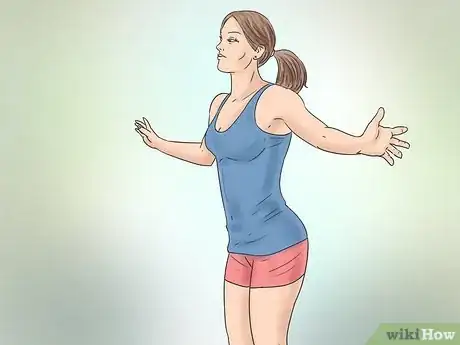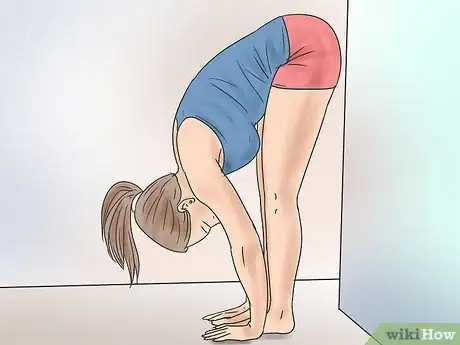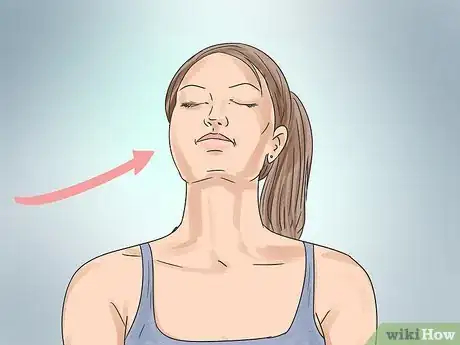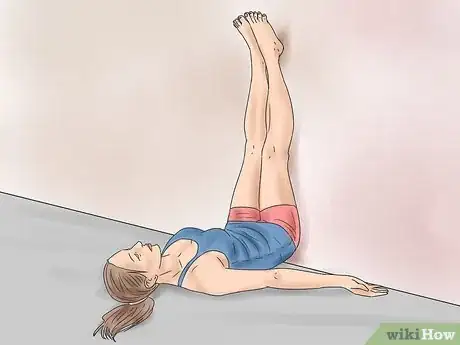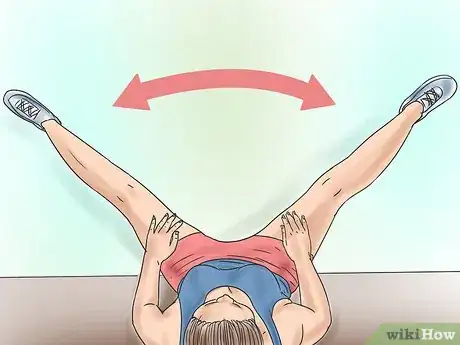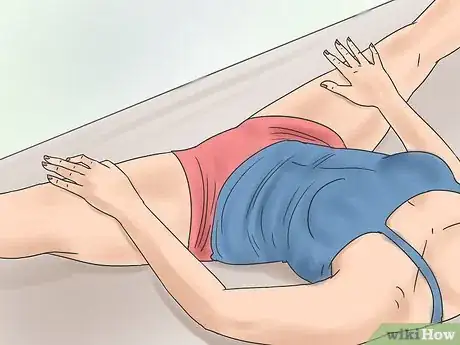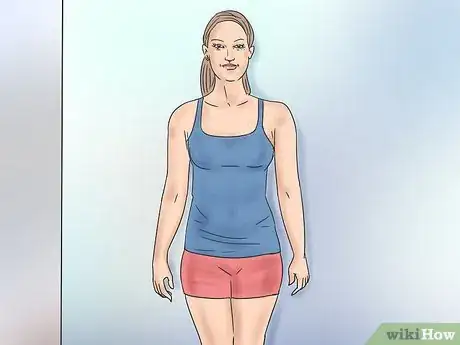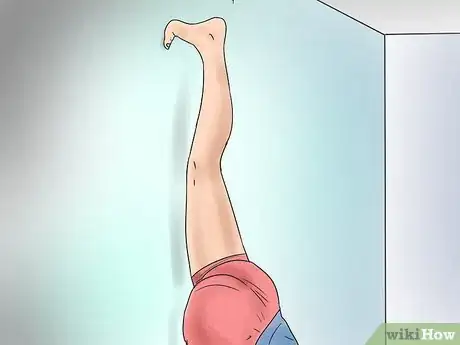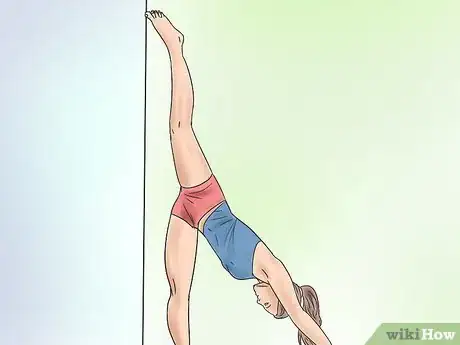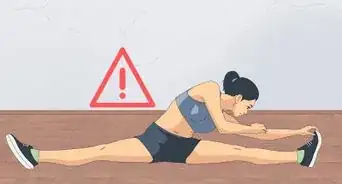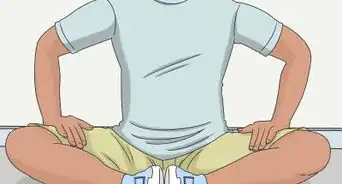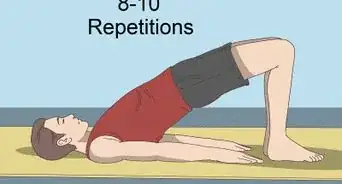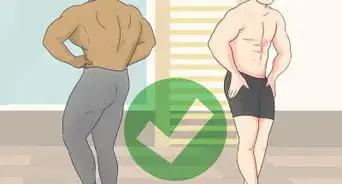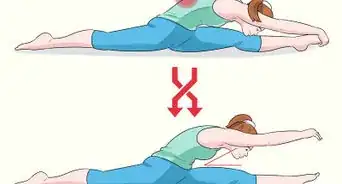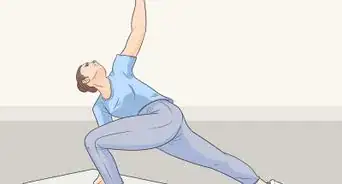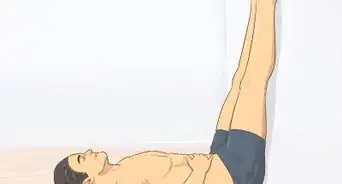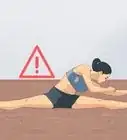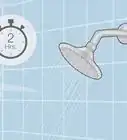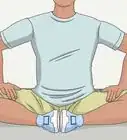This article was co-authored by Dean Theriot. Dean Theriot is a Personal Trainer and the Owner of Timberline Fitness in Houston, Texas. With over 25 years of experience in the fitness industry, Dean specializes in personal, group, and sport-specific training. Dean holds a BS in Exercise Physiology from LSU. Dean combines resistance and cardiovascular training with pilates exercises for comprehensive workouts for his clients. His sport-specific training includes football, basketball, and baseball.
There are 10 references cited in this article, which can be found at the bottom of the page.
This article has been viewed 54,143 times.
Performing splits against a wall is a great yoga technique for improving flexibility. You do not have to be flexible enough to do a split on the ground to perform wall splits. Always warm up your body and stretch before you attempt a wall split. With regular practice and good technique, your wall splits will continue to get better.
Steps
Warming Up Your Body
-
1Get your blood pumping. Engage in at least 5 minutes of aerobic activity such as biking, jogging, walking, or jump roping. Warming up increases your body temperature and blood flow to your muscles. This allows your muscles to be more flexible and decreases your risk of injury.[1]
- Never attempt a wall split without warming your body up first. Ten to fifteen minutes of warming up is ideal.
- Your warm up routine should engage the same muscles that you will use during your wall split. Jumping jacks, squats, lunges, high knees, and leg swings are good warm up exercises.[2]
-
2Stretch your muscles. Once your body is warm, do some static stretching. Static stretching is the form of stretching that you are probably most familiar with. You stretch a muscle or muscle group and hold that position[3] for 20 - 60 seconds. Repeat each stretch 2 to 6 times.
- Your stretching session should last for less than 10 minutes.
- Stretch your hip flexors, hamstrings, back, calves, and inner thighs.[4] Move in and out of each stretch slowly and gently.
Advertisement -
3Breathe as you stretch. Many people forget to breathe when they stretch. However, proper breathing makes your stretching more effective. Inhale slowly through your nose, hold your breath for a few seconds, and then exhale through your nose or your mouth. Your breathing should be slow and relaxed.[5]
- Your body becomes more relaxed as you exhale so feel free to lean in on your stretch as you are exhaling.[6]
- Holding your breath as you stretch will cause your muscles to be more tense.
-
4Create a regular stretching schedule. Regular stretching will increase your overall flexibility and improve your wall splits. Warm up your muscles and stretch every day. If you are consistent, you should reach maximal flexibility in your lower body within two months.[7]
- If you are older or naturally inflexible, it will take you longer to improve your flexibility.
- You should not feel pain as you stretch or the day after you stretch. If you experience this, you are pushing your muscles too hard. Stop your stretching routine until the pain has stopped.[8]
- Remember that increasing flexibility is a gradual process. Only stretch your muscles as far as they are willing to go.
Doing Middle Splits
-
1Position your body. Lay on your back with your legs facing the wall and your heels resting on the wall. Bend your knees and place your legs against the wall. At the same time, use your arms to move as close as possible toward the wall. Try to get your butt as close to the wall as possible.
- If you experience any discomfort in your lower back, move your body away from the wall. You can place a pillow or folded up blanket beneath your lower back for extra support.[9]
- If your neck feels strained, place a rolled up towel underneath your neck.
-
2Open your legs slowly. Slide your legs down the wall in the opposite direction slowly until they can go no further. Breathe as you lower your legs.
- Press very lightly on your legs with your hands to get a deeper stretch. However, do not press to the point where you feel pain.
- You may be able to spread your legs further apart by creating tension and then relaxing your legs. To create tension, pull your legs away from the wall and lift your head and chest. Relax, create tension, and then relax again. Now press lightly on your legs to see if you can widen your split.[10]
-
3Hold your split. Hold your stretch for a few seconds at first. Over time, gradually work your way up to 20-30 seconds. Once the time is up, use your hands to gently bring your legs back together and rest them against the wall. Repeat this 2-3 times. Remember to breathe as you hold your split.[11]
- As you continue to practice, try to increase the amount of time you hold your split.
- If you are sore the next day, you may have pushed your body too much. Do not practice your splits anymore until the soreness is gone.
Doing Single Leg Splits
-
1Stand with your back against the wall. Reach your arms over your head, bend at your hips, and place your hands on the floor. Keep your legs straight, but do not lock your knees. Rest your body weight on your hands and your foot that will remain on the ground.
- Inhale as you reach your arms above your head and exhale as you bend down.
- The more flexible you are, the closer your body will be to the wall. If you are not very flexible, position yourself farther away from the wall.
- You should always be able to comfortably touch the wall with your foot while your hands and other foot are on the ground.
-
2Slide your leg against the wall. Place the ball of your foot against the wall and slide your leg up the wall. Use slow, controlled movements as you do this. Your arms should be supporting the majority of your body weight.[12] Remember to breathe as you slide your leg up the wall.
- Your hips will try to rotate outwards, but keep them in a square position. It may be helpful to curl your toes to keep your hips aligned.[13]
- Push your hands into the ground to help you hold your lifted leg.
- Once you are in a stable position, try walking your hands closer towards the wall to get a deeper stretch. Make sure you keep your abs contracted so you don't injure your lower back.
-
3Hold the position. Hold your position for 2-3 breaths. Walk your hands out and slowly bring your leg down. Rest on your knees and then repeat the same steps using your other leg.[14]
- You may be more flexible on one side of your body. If this is the case, you may need to practice more with that side.
- The kneecap of your standing leg should be facing forward. Rotating your knee in this position can cause knee damage.[15]
- If you begin to feel pain, stop your split and rest. Do not sacrifice good technique to have a more impressive split.
Expert Q&A
-
QuestionHow can I get more flexible if I'm working toward a wall split?
 Dean TheriotDean Theriot is a Personal Trainer and the Owner of Timberline Fitness in Houston, Texas. With over 25 years of experience in the fitness industry, Dean specializes in personal, group, and sport-specific training. Dean holds a BS in Exercise Physiology from LSU. Dean combines resistance and cardiovascular training with pilates exercises for comprehensive workouts for his clients. His sport-specific training includes football, basketball, and baseball.
Dean TheriotDean Theriot is a Personal Trainer and the Owner of Timberline Fitness in Houston, Texas. With over 25 years of experience in the fitness industry, Dean specializes in personal, group, and sport-specific training. Dean holds a BS in Exercise Physiology from LSU. Dean combines resistance and cardiovascular training with pilates exercises for comprehensive workouts for his clients. His sport-specific training includes football, basketball, and baseball.
Personal Trainer One way to prepare for a wall split is to do a hip flexor stretch on a Pilates reformer. Facing the bottom of the reformer, place your foot on the floor next to the foot bar. Place your left knee in the middle of the padded part of the machine. Make sure there aren't any sprints attached, then hold the foot bar and allow the left knee to travel away from your hands. Because most reformers are elevated, you shouldn't be limited by anything other than your own hip flexor flexibility. When you're able, extend the knee of your right leg to achieve an even greater stretch.
One way to prepare for a wall split is to do a hip flexor stretch on a Pilates reformer. Facing the bottom of the reformer, place your foot on the floor next to the foot bar. Place your left knee in the middle of the padded part of the machine. Make sure there aren't any sprints attached, then hold the foot bar and allow the left knee to travel away from your hands. Because most reformers are elevated, you shouldn't be limited by anything other than your own hip flexor flexibility. When you're able, extend the knee of your right leg to achieve an even greater stretch. -
QuestionWhat do I do if my knee hurts even if my split is touching the wall?
 Community AnswerIt depends. If it is the back of the knee, that is good - you are stretching. If it's the front, stop, and maybe go see a doctor.
Community AnswerIt depends. If it is the back of the knee, that is good - you are stretching. If it's the front, stop, and maybe go see a doctor. -
QuestionI'm not flexible; how do I become more flexible?
 Community AnswerConsult Become Flexible and Get Flexible Fast for some good tips.
Community AnswerConsult Become Flexible and Get Flexible Fast for some good tips.
References
- ↑ http://web.mit.edu/tkd/stretch/stretching_5.html#SEC39
- ↑ http://www.fitbodyhq.com/fitness/how-to-do-the-splits/
- ↑ http://web.mit.edu/tkd/stretch/stretching_4.html#SEC33
- ↑ http://www.fitbodyhq.com/fitness/how-to-do-the-splits/
- ↑ http://web.mit.edu/tkd/stretch/stretching_5.html#SEC57
- ↑ http://www.fitbodyhq.com/fitness/how-to-do-the-splits/
- ↑ http://web.mit.edu/tkd/stretch/stretching_5.html#SEC58
- ↑ http://web.mit.edu/tkd/stretch/stretching_5.html#SEC58
- ↑ http://www.cnyhealingarts.com/2011/02/07/health-benefits-of-viparita-karani-legs-up-the-wall-pose/
- ↑ http://www.sensational-yoga-poses.com/yoga-poses-using-a-wall.html
- ↑ http://www.fitbodyhq.com/fitness/how-to-do-the-splits/
- ↑ http://www.yogajournal.com/article/practice-section/the-high-point/
- ↑ http://www.yogajournal.com/intermediate-section/standing-splits/
- ↑ http://www.yogajournal.com/article/practice-section/the-high-point/
- ↑ http://yogabycandace.com/blog/2013/8/8/how-to-do-a-standing-split
